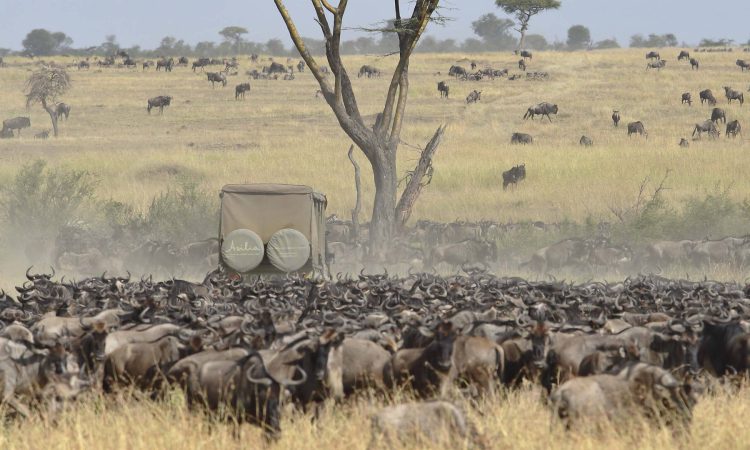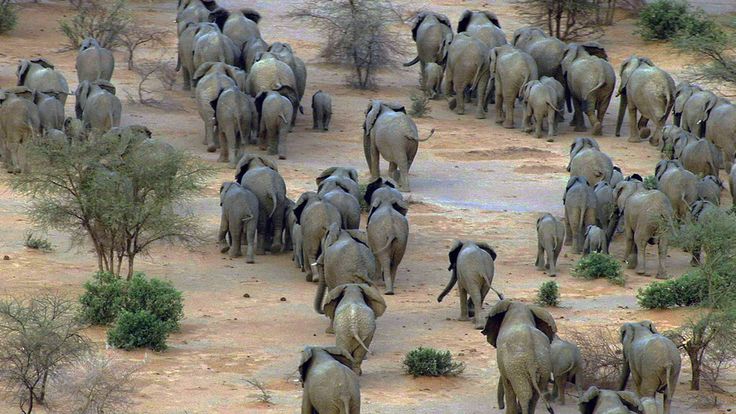Top 7 Africa Wildlife Spectacles And Experiences For An Unforgettable Safari : Africa’s huge continent is home to some of the most amazing wildlife gatherings on the planet. You’ve probably heard about the incredible migration of one million wildebeests across Tanzania and Kenya. However, there are many more lesser-known examples across the continent. Each one shares their own incredible story of risk, perseverance, and magnificence. Let’s go over some of them to be sure you don’t forget any.

Here are our top 7 Africa Wildlife Spectacles and Experiences you absolutely should experience on your trip to Africa.
- The Great Migration of Wildebeest, Kenya, and Tanzania
- Lake Nakuru migration of flamingos, Kenya
- The Sardine Run, South Africa
- Bat migration in Kasanka National Park, Zambia
- Migration of Southern Right Whales, South Africa
- Turtle hatchlings at Sodwana Bay, South Africa
- Elephant migration, Mali
- Mountain gorilla, Uganda and Rwanda
The Great Migration of Wildebeest, Kenya, and Tanzania
If you have only heard of one wildlife spectacular in Africa, it is most likely the Great Migration of the Wildebeest. In a magnificent mass movement, almost one million of the powerful and graceful creatures seek better grazing pastures during the annual pilgrimage. Hundreds of thousands of zebras and gazelles accompany them on their journey. The remarkable journey of the animals takes them in a clockwise rotation throughout northern Tanzania and Kenya, passing through the Serengeti and Masai Mara areas.
This annual voyage normally begins around April, when the herds leave the Serengeti in search of more water and grass. They usually arrive in Kenya’s Masai Mara around July. Following that, it’s a long drive back to the southern Serengeti for the winter season. Despite their large numbers, the animals’ journey is fraught with danger. The large number of herbivores attracts a plethora of hungry predators hunting for an easy meal. Both big cats and hyenas prowl the borders of the moving beasts, hunting for weaker prey to take advantage of. Perhaps the most terrible event for the herds is the perilous crossing of the Grumeti River. Huge Nile crocodiles lurk beneath the filthy waters, ready to drag the defenseless beasts into the depths below.
Lake Nakuru migration of flamingos, Kenya
You could be forgiven for believing you’d drifted into a fantastic dream at first glance. As you gaze across Kenya’s massive Lake Nakuru, you will see something unlike anything you have ever seen before. Hundreds of thousands of pink birds with long legs and necks flock neatly around the water’s edge. But, of course, what you’re witnessing is not a dream, but the great flamingo migration—a natural occurrence worthy of your bucket list. Around 300,000 of the amazing birds travel to the area each year to take advantage of the water’s magical abilities. The alkaline-saline lake has a pH of 10.5—an ideal habitat for the growth of algae, which the birds like eating. While the sheer number of birds appears to be astonishing, it was far higher just a few years ago. Around two million lesser flamingos previously flocked to the Rift Valley Lake. This figure has been steadily decreasing due to rising water levels, which reduce salinity and algae in the water. Although many of the birds have begun to go elsewhere for food, the display remains breathtaking.
The Sardine Run, South Africa
We all feel safer with friends by our sides when things turn dangerous. And it appears that South African sardines have absorbed this concept. Millions of fish assemble for the Sardine Run, which takes place from May to July and travels up the Eastern Cape of the nation. The figures are astounding. There are shoals that are said to be up to 7 km long, 1.5 km wide, and 30 meters deep. However, the adventure they are on is incredibly dangerous.
The world’s most infamous predators are drawn to the massive assembly, which is the biggest biomass movement on Earth. Whales, sharks, and dolphins emerge from the deep to attack from below. Together, the sardines dart in a dazzling mass to fend off their assailants. Seabirds, however, launch aerial assaults, rendering escape nearly impossible. The outcome is breathtaking carnage when the predators devour hundreds of sardines. Why, therefore, do they accept this risky yearly challenge? The peculiar issue is that we can’t be certain. There are several ideas out there, but the one that makes the most sense is probably the one about sardines migrating north to breed. But in the absence of further scientific research, the amazing voyage remains a mystery.
Bat migration in Kasanka National Park, Zambia
Perhaps because of their unjustified link with vampires, bats have a bad reputation. However, you feel about the creatures, you just must not miss the Kasanka bat migration as a wildlife event. Approximately 10 million straw-colored fruit bats descend onto Kasanka National Park in northern Zambia each year for this amazing occasion.
For just a month and a half, from late October to mid-December, the stunning creatures travel to the region to feast on the abundant fruit. Throughout the day, the guests occupy every available inch as they dangle from the nearby trees. They depart for their feast as the sun sets, covering the sky in a black blanket. You’ll be relieved to know that these particular bats only consume fruit and have no desire to drink blood, if that eases your phobia of flying monsters. That does not, however, make their appearance any less amazing. With wingspans of less than one meter, the enormous animals—often referred to as flying foxes—can consume five thousand tons of fruit per night.
Migration of Southern Right Whales, South Africa
The first thing that springs to mind when we consider the best wildlife spectacles in Africa are the enormous land beasts traversing the continent. However, there is an annual aquatic adventure off the coast of South Africa that surpasses any event held on the plains. Southern right whales gather in the Western Cape between June and October for the critical calving and mating seasons. They have traveled thousands of miles on this adventure, from the icy waters of Antarctica to the extreme tip of Africa. The highly clever creatures are here for serious business, but they also spend a lot of time playing and engaging with each other.
The animals’ enormous size is what gives the event its breathtaking quality. Southern right whales can grow up to 18 meters in length; however, they are often only 5.5 meters long at birth. Furthermore, an adult at full growth might weigh an astounding 80 tons. Over a hundred whales congregate annually in the Hermanus area, making it one of the greatest spots to witness the show. Whales frequently approach the coast so close that landowners can see them.
Turtle hatchlings at Sodwana Bay, South Africa
Even though enormous animals traveling on epic treks provide for many of Africa’s most breathtaking wildlife displays, sometimes smaller adventures can be just as inspirational. Huge female loggerhead and leatherback turtles come out of the ocean every year, beginning in November, to find a location to give birth. Once they’ve located a location they like, the mothers need to have enough space to bury 80–100 eggs, which leads to a laborious digging process. After finishing, they must pull themselves back into the sea and depart in search of freedom.
The spectacle doesn’t stop there, even though the sight is enough to move even the toughest heart to tears. The turtle hatchlings are prepared to enter the world after about 70 days. The babies, left to fend for themselves, have to crawl across the sand and crack through their eggs before running for the open waters. For everyone witnessing this genuinely inspirational occurrence, it serves as a lesson in tenacity and perseverance.
Elephant migration, Mali

The countryside around Timbuktu can be harsh. Situated on the southern border of the Sahara, the average temperature surpasses 40 °C (104 °F), and there is no precipitation from around October to March. For many creatures, it can be nearly impossible to survive in desert regions. Therefore, it may come as a surprise to learn that an animal as big and elegant as the African elephant can flourish in the hard environment there. Nevertheless, these magnificent animals have established themselves here and embarked on one of the world’s most amazing migrations.
The giants cover a 32,000 km2 area, from the northern Niger River to the southern borders of Burkina Faso and Mali, in a single file as they look for food and water. It’s said that their amazing voyage is the world’s longest elephant migration. Even though they are such extraordinary and rare animals, the roughly 300 desert elephants are always in danger of going extinct because of poaching and conflict. It is hoped that fresh conservation initiatives will preserve this spectacle for upcoming generations.
Mountain Gorillas in Uganda, Rwanda, and the Democratic Republic of the Congo
People who have been fortunate enough to interact with wild mountain gorillas describe the experience as profound, bordering on transcendence. Their facial expressions convey something fundamental about what it means to be a sentient being. Knowing that every visit makes a substantial contribution to the survival of these magnificent animals makes it even more important.
You can experience this last remaining mountain gorillas in Virunga National Park in the Democratic Republic of the Congo, Volcanoes National Park in Rwanda, and Bwindi Impenetrable National Parks in Uganda.
CONCLUSION: AFRICA TRULY DOES HAVE IT ALL.
Many of us immediately picture safaris when we think about Africa. We may think of the Big Five—the lion, leopard, elephant, buffalo, and rhino—more precisely. However, the continent is actually a vast and diversified landmass. Africa is home to enormous flocks of pink flamingos and majestic ocean giants. Make sure to attend one of these amazing events if you are fortunate enough to travel to the continent. It will always be a part of you.


